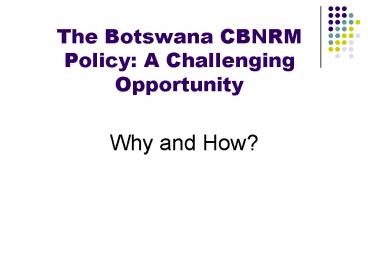The Botswana CBNRM Policy: A Challenging Opportunity - PowerPoint PPT Presentation
1 / 15
Title:
The Botswana CBNRM Policy: A Challenging Opportunity
Description:
The Botswana CBNRM Policy: A Challenging Opportunity Why and How? CBNRM POLICY 1996 - Drafting Commenced 1999 - Savingram from PS, Local Government and Lands ... – PowerPoint PPT presentation
Number of Views:126
Avg rating:3.0/5.0
Title: The Botswana CBNRM Policy: A Challenging Opportunity
1
The Botswana CBNRM Policy A Challenging
Opportunity
- Why and How?
2
CBNRM POLICY
- 1996 - Drafting Commenced
- 1999 - Savingram from PS, Local Government and
Lands proposing that CBNRM revenues should go to
the District Councils not CBOs - 2002 - Wildlife vs Diamonds arguments
- 4 th Draft of the Policy inclusive and balanced
(2003) - 2003 - Second Proposal on money going to
District Councils - 5 th draft of the CBNRM Policy reaction to the
Mismanagement of funds in CBOs (2005) biased
towards wildlife resources - 2006 CBNRM campaign using a theater group
play performed in all the wildlife based CBOs,
MEWT conferences and CBNRM workshops - 2006 CBNRM play turning point in the Botswana
CBNRM history - APPROVAL DATES CABINET 26 /07/ 2006
Parliament 26/ 07/ 2007
3
Challenges
- Resource utilisation royalty will be paid to the
Ministry of Environment, Wildlife and Tourism not
District Councils as before. - CBOs shall collect socio-economic data to support
sound CBNRM practices. - Government will set resource harvesting quotas.
4
OBJECTIVES (opportunities)
- Create a foundation for conservation-based
development - Specify land tenure and natural resources user
rights, which may be devolved to communities - Protect the intellectual property rights of
communities with regard to NRM - Encourage communities to participate meaningfully
in CBNRM monitoring. - Facilitate capacity building within communities
to engage in natural resources-based tourism - Establish an institutional support framework for
the implementation of CBNRM - Promote communication, education and public
awareness on CBNRM.
5
Challenges
- The involvement of the private sector in tourism
concessions must continue but local communities
will be encouraged to buy shares in such
ventures. - The decision to award the tender to a particular
joint venture partner will however rest with the
TAC. The tender award decision will be subject to
written approval by the Land Authority. - Institutional capacities of NGOs will be
strengthened to meet specific needs of
communities.
6
Challenges
- proceeds of the sale of natural resource
concessions and hunting quotas - 35 may be retained by the CBO.
- 65 shall be deposited in the National
Environment Fund. - The Minister may however, vary these percentages
depending on the circumstances and needs of a
particular CBO.
7
National Environmental Fund
- 65 of funds derived from the sale of natural
resource concessions and hunting quotas shall be
deposited into NEF. - To finance the community based environmental
management and eco-tourism projects throughout
the country. - The Fund will be managed by a Committee appointed
by the MEWT. - The DEA will provide a Secretariat for the Fund.
8
Recommendations
- Development of the Policy Implementation Plan
- Pre-Policy Implementation analysis
- Development of the constitution guidelines
- Review of the existing CBOs constitutions and
aligning them with the policy. - National CBNRM baseline survey
- Establishment of an integrated CBNRM performance
database - Development of institutional annual action plans
example CAPs - Continuous ME
- Initiatives for adding value to CBNRM
9
Objectives of CBNRM Policy - PIP
- To facilitate the effective participatory
implementation of the policy - To enhance communication between stakeholders
- To ensure that stakeholders understand their
roles - To identify opportunities, challenges and gaps
- To determine institutional capacity and
strengthening needs - To identify and strengthen linkages between CBNRM
and other development initiatives
10
EXPECTED OUTPUTS OF THE PIP
- Broad CBNRM Policy Implementation Plan and annual
work plans ( 4 year plan and annual plans) - Setswana version of the CBNRM Policy
- CBNRM policy publicity materials
- CBNRM performance data
- Regular policy briefs for decision makers and
stakeholders - Harmonization of the CBNRM institutional
structures - Broader understanding of the CBNRM Policy by
stakeholders - Clear definition of roles for different
stakeholders
11
Adding Value to CBNRM
- To expand opportunities and alternatives for
sustainable rural livelihoods - To promote conservation and build stocks
- To enhance sustainability of CBNRM
- How?
- Diversifying CBNRM activities
- Designing suitable implementation models
12
Objectives of the Agric Based Initiatives
- To promote food production and security.
- To assist in poverty alleviation.
- To create employment opportunities.
- To promote the spirit of self-reliance in the
communities.
13
Linking CBNRM with other livelihoods sources -
Agriculture
- WHY Agric-Based Initiatives for Conservation?
- Divert the socio-economic dependency from the
natural resources - Reduce commercialization of NR
- Reduce unsustainable harvesting of NR
- Create awareness on how a healthy natural
ecosystem support agriculture. - Ownership and control
14
How will the project be carried out?
- Interest groups will form the production units
(10 15 members) - Membership will be on a share-holding basis.
- CBO will own a certain percentage of shares and
the members of the production unit will share the
remaining percentage equally. - The Production Units will start with ownership of
around 40 and as time goes by and their
managerial skills and abilities improve, they
earn more shares. - The checks and balances for auditing the
performance of the production units will be put
in place - The highest shares that a Production Unit could
own could be 60 or 75 and the rest remain with
the Trust. - The Trust will use the profits to fund new
Production Units or maintain old ones when
necessary.
15
- Its not the policy itself that matters, it is
its implementation arangements that moves
mountains!!!!































